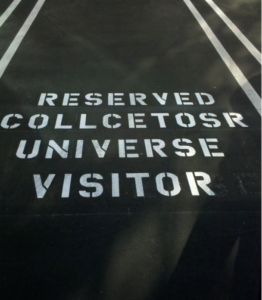You’d have thought that once you’ve been a Universe, there’s no bigger space left for you to occupy.
Turns out, there is. Collectors may have dropped “Universe” from its brand name, but Collectors Holdings, Inc. seems to be expanding in much the same way the physical universe is: energetically, in all directions, and at speeds difficult to comprehend. As a 20-year veteran at this company, I have witnessed expansions before… but nothing compared to what we are experiencing now. This is not the same company that it was when I came on board in early 2002, but then again, it’s not operating in the same marketplace (or even the same world). Yet, some things will always remain constant.
Collecting Is About Passion
One dictionary definition of “passion” is “strong and barely controllable emotion,” and I can’t think of a better description of what drives collectors. Most collectibles have little inherent value – a T206 Honus Wagner may sell for a fortune, but it is ultimately just a piece of old cardboard with some ink on it. It’s the interest, the drive, the passion of collectors that elevates that little paper rectangle to a million-dollar item. People collect things because they love them, and love is a powerful thing. It can make you crazy sometimes, maybe even a little obsessive, and it can leave you vulnerable.
That’s where we come in. Our job is to protect collectors – from misinformation, from lack of clarity, and from outright lies. The collectibles world is awash in fakes and forgeries of course, but it’s also overwhelmed by clashing opinions regarding provenance and condition. Before PCGS (Professional Coin Grading Services, the company that laid the foundation for Collectors) pioneered the concept of third-party grading, one collector’s “near-mint” was another’s “poor.” Commerce was hampered because people couldn’t agree on the reality of the product they were attempting to trade in. It was too easy for buyers to fall victim to scams, and too difficult to engage in good-faith transactions because of uncertainty regarding the items being bought or sold.
PCGS (and later PSA, WATA and other grading companies) changed all that by offering an objective, third-party evaluation of collectibles. People who collect can now engage in the market with greater confidence because PSA, PCGS or WATA certified that an item is what it claims to be and is actually in a specific condition.

Our Reputation Is Our Product
Think about it for a moment. In an industry where fakers and forgers seem to lurk behind every other online seller account or “custom printer,” people rely on us to be the truth-tellers. That’s a huge responsibility. It means that everything we do matters. Words matter. Details matter. Data matters. Our passion for the items we grade matters. Folks know a fellow collector when they meet one; they feel an immediate kinship because the other person “gets it” in a way that non-collectors don’t. We “get it” and our customers know we do. As we expand, we must continue to “get it” on the same level as our customers. The moment we stop, customers will lose faith and look for a different authority to put their trust in.
The Collectors family of services rose to preeminence because we have always employed the top experts in the field. We strive to hire the best researchers and the best graders – and we proudly stand by the belief that we have the best of the best – but people don’t often think about our receivers, customer care reps, shippers, engineers and so on. They need to be the best too, because all that they do feeds into the final product and customer experience. Our reputation rests on everybody here.
Every Collectible Is a Treasure
A refrain often heard at Collectors is “Every card is a Mantle” (or “Every coin is a 1933 Double Eagle” or “Every game is a 1990 Nintendo World Championships cart”). It means that any collectible that comes through our doors may be a treasure of great value. Not every item will be a rare gem with a tremendous resale price, but any item could be someone’s sentimental favorite or valued family treasure. Even those that aren’t so special are still someone’s personal property that they have commended into our care. We need to do right by every item – which means not only treating the physical item well, but also treating its digital representation with the same care. Members of the Tech staff, such as myself, need to give the data the same level of attention that the graders and sealers give to the physical collectibles.
Technology Is a Means, Not an End
This point may be the hardest for us technologists to remember. As techies, we’re always drawn to the shiny new languages or software platforms that come along. We love to learn about them and tinker with every new framework that pops up.
Of course, technology changes rapidly, and we need to keep tabs on the current state-of-the-art to avoid falling behind. New tech indeed may be a good fit for our products, if it enables a better customer experience. So absolutely we should pay attention and update things as needed.
The thing to keep in mind is that customers don’t care about any of this. Shiny new websites and slick interfaces are fine, but what customers really want is a more seamless way to engage with their beloved collectibles. The infrastructural underpinnings, the database engines, the software frameworks that support it – that stuff doesn’t matter to them. It just needs to work. One of my favorite quotations is from an episode of the TV series Futurama: “When you do things right, people won’t be sure you’ve done anything at all.” It couldn’t be more true in our world.
Our ultimate goal is to build things that work well for the customer while minimally disrupting their experience. “Disruption” often has a positive connotation in our world, referring to the phenomenon of new tech shaking up and improving old methods – but customers usually don’t appreciate disruption. Sometimes it’s necessary, but it shouldn’t be forced on customers without good reason. Our job may be to make things work, but don’t lose sight of the “why” when focusing on the “how.”
The Future Comes from the Past
To state the obvious, everything new emerges from what came before. The applications, data structures and business processes we have today are descended from an earlier era in the company’s history. When I joined Collectors, the entire Tech staff was less than 10 people. It has grown over my entire tenure here, but the rate of growth has expanded rather dramatically in the past 2-3 years as the company is working to achieve new, expanded goals.
New data and information systems are being built now, but much of the foundation was laid during that earlier, smaller era. The tiny engineering teams back then had to make do with many limitations, which meant that sacrifices had to be made in terms of system efficiency and redundancy. It may not always seem like it, but things are usually the way they are for a reason. Systems that now seem unnecessary or confusing made sense at the time they were built.
While old solutions are very often no longer the best options for today’s problems, it’s imperative to learn from the prior processes and tech products while crafting their replacements. The engineers and product directors of the past probably wrestled with the same problems that today’s will, and old solutions can help inform the new ones. In particular, operations that may seem inscrutable at first might be clues to a costly edge case that would be easy to miss otherwise. Collectibles are a wide world with all kinds of quirks and details that generate all manner of unusual scenarios. It can be tempting to write these off as edge cases that aren’t worth too much investment, but we must remember that collectors are driven by passion over minutia. Sometimes the unusual and quirky parts are the most important ones!
In Closing
Collectors is in a unique position in a unique industry. It’s a good place to be, and can be a fun one too. But it’s a serious kind of fun. The trust that Collectors has today was hard to earn and can be easy to lose. Luckily, our customers are actually on our side; they want the truth and stability we offer – but they’re always vigilant. They’ve placed a lot of faith in us. We need to continue to earn that faith and keep the customers’ needs at the top of our priority list. The company values that we label “collector obsession” and “getting it right” mean that we need to think like collectors, including their ability to zero in on every little detail. It may seem silly at times, but it makes sense. It’s a wide, diverse and sometimes crazy universe, but it’s a fun one to live in.
William Cassidy
William Cassidy is a veteran Software Engineer at Collectors. Over 20 years at Collectors, he built many foundations of Collectors technology, including work on its Grading platform, Accounting system and various areas of consumer-facing PCGS and PSA websites. Apart from his technical expertise, William is also a lifelong collector of vintage video games. In addition to his computer science knowledge, he holds a history background and has a passion for writing and editing.


